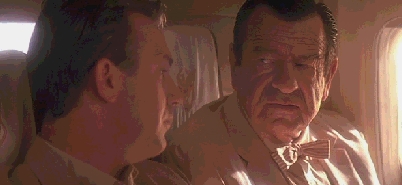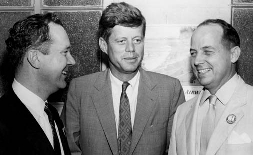The JFK 100
Senator Russell Long Summarizes the Assassination

Walter Matthau (right) as Louisiana Senator Russell Long,
with Jim Garrison (Kevin Costner)

Walter Matthau (right) as Louisiana Senator Russell Long,
with Jim Garrison (Kevin Costner)
The stewardess brings more drinks.LONG Don't get me started on that. Those Warren Commission fellows were pickin' gnat s*** out of pepper. No one's gonna tell me that kid did the shooting job he did from that damned bookstore.
STEWARDESS Here you go, Senator Long.
JIM (surprised) I thought the FBI test-fired the rifle to make sure it could be done?
LONG Sure, three experts and not one of them could do it! They're telling us Oswald got off three shots with world-class precision from a manual bolt action rifle in less than six seconds -- and accordin' to his Marine buddies he got Maggie's drawers -- he wasn't any good. Average man would be lucky to get two shots off, and I tell ya the first shot would always be the best. Here, the third shot's perfect. Don't make sense. And then they got that crazy bullet zigzagging all over the place so it hits Kennedy and Connally seven times. One "pristine" bullet? That dog don't hunt.(1)
Does Oliver Stone have his facts straight?

Senator Russell Long (left) with John F. Kennedy
and New Orleans Mayor Chep Morrison in 1956
Let's take Stone's second contention first.
They're telling us Oswald got off three shots with world-class precision . . .False. It is almost universally agreed that one shot missed the limousine completely from point-blank range. (Stone is, at best, exaggerating about the skill demonstrated with the other shots.)
. . . from a manual bolt action rifle in less than six seconds . . .False. The Warren Commission never stated that Lee Harvey Oswald fired three shots in under six seconds.
What did the Commission say?
Based upon an evaluation of the home movie taken by bystander Abraham Zapruder, the Warren Commission concluded that
the time span between the shot entering the back of the President's neck and the bullet which shattered his skull was 4.8 to 5.6 seconds. If the second shot missed, then 4.8 to 5.6 seconds was the total time span of the shots. If either the first or third shots missed, then a minimum of 2.3 seconds (necessary to operate the rifle) must be added to the time span of the shots which hit, giving a minimum time of 7.1 to 7.9 seconds for the three shots. (Emphasis added.)(2)
The growing consensus among assassination researchers is that the first shot was fired at about frame 155 of the Zapruder film, and missed. If correct, this would give Oswald an ample 8.6 seconds to fire three shots.
But, as Oliver Stone himself inadvertently demonstrates during the course of JFK, six seconds would also have been enough time to fire three shots from Oswald's rifle.
Returning to Stone's first point . . .
Sure, three experts [test-fired the rifle] and not one of them could do it [duplicate Oswald's feat]!False. This is only accurate if one assumes that Oswald succeeded in hitting his intended target three out of three times.(3)
The Warren Commission concluded, however, that only two out of three shots fired were successful; one missed.(4) As noted above, it is almost universally agreed that there was a missed shot.
-- and accordin' to his Marine buddies he [Oswald] got Maggie's drawers -- he wasn't any good.
It is true that one of Oswald's Marine buddies, Nelson Delgado, made this comment to the Warren Commission.(5) But documentary evidence from Oswald's Marine Corps file proves that -- during his time in the Marines, at least -- Oswald was a perfectly capable marksman.(6)
Average man would be lucky to get two shots off, and I tell ya the first shot would always be the best. Here, the third shot's perfect. Don't make sense.
Stone presents no evidence to support this claim. Quite to the contrary, a number of researchers have pointed out that, due to such factors as the angle the limousine was traveling in relation to Oswald's vantage point in the Texas School Book Depository window, the third shot would have been the easiest.(7)
And then they got that crazy bullet zigzagging all over the place so it hits Kennedy and Connally seven times.
A wealth of hard evidence supports the hypothesis that one bullet struck both President Kennedy and Governor Connally, causing a total of seven wounds. Absolutely no "zigzagging" was required; this is a myth that has been soundly debunked.
One "pristine" bullet? That dog don't hunt.The bullet was far from pristine, and its condition has been shown to be a precise result of the sort of damage it inflicted upon President Kennedy and Governor Connally.
One final note: Oliver Stone also has Russell Long suggest to Jim Garrison that Lee Harvey Oswald was nothing more than "a good old-fashioned decoy."(8)
But while Russell Long did have doubts about Oswald being the sole assassin, he did not believe that Lee Oswald was a mere decoy. On the third anniversary of the assassination -- close to the time Long and Garrison had their fateful conversation -- the New York Times stated, "Senator Russell Long of Louisiana suggests a new investigation because of the doubts he has. Long believes Lee Harvey Oswald played a role in the assassination but suggests that someone else was involved."(9)
When, during that fateful flight in 1966, Jim Garrison asked Senator Long who would have had a motive to kill President Kennedy, Long replied, "I wouldn't worry about motive until I find out if there appeared to be more than one gunman."(10)
Apparently, Russell Long wasn't quite the Warren Commission expert Oliver Stone would have us believe.
You may wish to see . . .
The JFK 100: The Single Bullet Theory
NOTES:1. Oliver Stone and Zachary Sklar, JFK: The Book of the Film (New York: Applause, 1992), p. 25. All quotations are from the shooting script and may vary slightly from the finished motion picture.
2. Report of the President's Commission on the Assassination of President Kennedy (U.S. Government Printing Office, 1964), hereafter the Warren Commission Report, p. 117. The Warren Commission Report is available online in its entirety.
3. Hearings Before the President's Commission on the Assassination of President Kennedy, hereafter the Warren Commission Hearings, Vol. III, pp. 441-51. The Hearings of the Commission are available online.
4. Warren Commission Report, pp. 111-17.
5. Warren Commission Hearings Vol. VIII, p. 235.
6. Warren Commission Report, pp. 189-93.
7. This is particularly true if, as strong evidence indicates, it was the first shot that missed. As researcher Dale Myers observes, ". . . the first shot was the only left-to-right tracking shot in the entire shooting scenario. This is a key point. A tracking shot is one of the hardest to accomplish and even more difficult considering the cramped, closed quarters that were dictated by the arrangement of the sniperís nest." Researcher Joe Elliot has posted some very specific data about the relative difficulty of the shots.
8. Oliver Stone and Zachary Sklar, JFK: The Book of the Film (New York: Applause, 1992), p. 26. All quotations are from the shooting script and may vary slightly from the finished motion picture.
9. Louis Sproesser, The Garrison Investigation: November 1966 to February 1968 (Sturbridge, Mass.: Southern New England Research, 1999), p. 9, citing the New York Times, November 22, 1966. According to Mark Lane (citing Jim Garrison as his source in an April 18, 1967, KNEW Oakland radio interview with Joe Dolan), Russell's concerns were prompted by a reading of Lane's book, Rush to Judgment.
10. Vincent Bugliosi, Reclaiming History (New York: W. W. Norton & Company), p. 1403 fn.
The JFK 100: The Single Bullet Theory